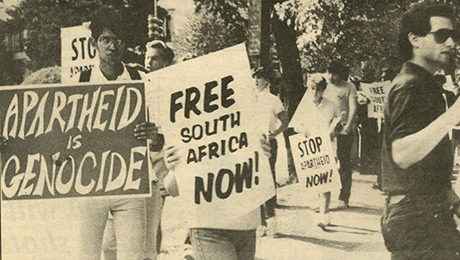By Lauren Ingeno
“If we don’t come out of there, hold up picket signs and call the TV stations,” Rep. Eleanor Holmes Norton, D-D.C., told the small group of activists gathered outside of the South African Embassy on Nov. 21, 1984.
In the wake of former South African President Nelson Mandela’s death, crowds of people have paid their respects at his newly erected statue, which stands in front of the South African Embassy—less than two miles away from GW’s Foggy Bottom Campus.
But the location was the site of a very different scene three decades ago: For two years, anti-apartheid protestors marched in front of the embassy, urging Congress to pass a sanctions bill that would cease trade relations with the country, a political move they thought could lead to Mr. Mandela’s release from prison.
On the day before Thanksgiving in 1984, GW’s current Assistant Vice President for District of Columbia Relations Bernard Demczuk, who was working as the political director of the American Federation of Government Employees in the '80s, was among the 21 protestors waiting outside the embassy at 3 p.m., and he remembers it clearly.
Rep. Walter Fauntroy, D-D.C., Commissioner the U.S. Commission on Civil Rights Mary Francis Berry and TransAfrica’s Executive Director Randall Robinson joined Rep. Norton, who was a Georgetown professor at the time, in plotting a meeting with the South African ambassador. Around 4 p.m., as rush hour was beginning, Rep. Norton walked outside where the picketers were waiting.
“The other three told the ambassador they weren’t leaving until they freed Mandela. And of course he told them, ‘You’re crazy.’ And then he made a fatal mistake, which we hoped he would do—he called the police,” recalled Dr. Demczuk.. “The rest is history.”
By the time Rep. Fauntroy, Ms. Berry and Mr. Robinson were escorted out of the embassy in handcuffs, local reporters caught the entire scene on camera. The next day, as families across the country were eating their Thanksgiving meals and watching the news, they were asking, “What’s this South Africa thing all about?” remembered Dr. Demczuk.
In the following weeks, dozens of Americans began showing up at the embassy.
“I would get five, 10, 20 people to show up at 4 p.m., march in front of the embassy and shout, ‘Free Mandela.’ Then at 5 p.m. they would walk in the middle of the street and sit down,” explained Dr. Demczuk, whose role it was to organize one D.C. trade union per week to protest.
For two years, hundreds of people in the city—from students and union workers to government employees and state representatives—held up traffic on Massachusetts Avenue.
Dr. Demczuk says GW students were particularly active in the anti-apartheid movement. Given its close proximity to the White House, GW became a “staging university” for the anti-war demonstrations in the 1970s, so its students were accustomed to political protests.
According to an archived American Committee on Africa newsletter, GW was the site of an anti-apartheid rally in April 1985. Following the rally, 90 GW students, faculty and staff joined students from Howard University, American University and the University of Maryland in a “funeral march” to the South African Embassy, where they protested alongside 4,000 District workers. Sixteen were arrested, including those from the student group, GW Voices for a Free South Africa, according to GW student media coverage.
At the start of the fall semester in 1985, 35 GW community members were involved in another protest. They marched down Massachusetts Avenue chanting, “No one is free until all of us are free,” and knocked on the embassy door, demanding an explanation for South Africa’s policy on racial segregation, reported the GW Hatchet.
That same year, the alleyway that runs through Kogan Plaza was being laid with fresh cement. While it was drying, GW students etched “Free Mandela” into the slab. When Kogan Plaza was reorganized 10 years ago, administrators decided to preserve the slab, and so the symbol of student activism still remains today.
Public demonstrations against South Africa spread nationwide, and thousands of people were arrested over the next two years, including more than 20 members of the House of Representatives, Jesse Jackson, Rosa Parks, Stevie Wonder and Coretta Scott King.
In 1972, Rep. Ronald Dellums, D-Calif., introduced the first anti-apartheid legislation, and in 1986 his bill was finally passed, withstanding a veto by President Ronald Reagan. The Comprehensive Anti-Apartheid Act of 1986 imposed economic sanctions against South Africa and listed conditions for ending the sanctions, including the release of Mr. Mandela and all political prisoners.
Soon, other countries followed suit, enacting their own sanctions. Mr. Mandela was released from prison in 1990.
Dr. Demczuk said that day before Thanksgiving in 1984 and the subsequent protests that followed were the “sparks” that raised awareness about apartheid in South Africa eventually led its dismantling in 1994.
“Mr. Mandela embodied the ideals of freedom, democracy and justice,” he said. “And I think that Americans have always been in the forefront of demanding those values.”


